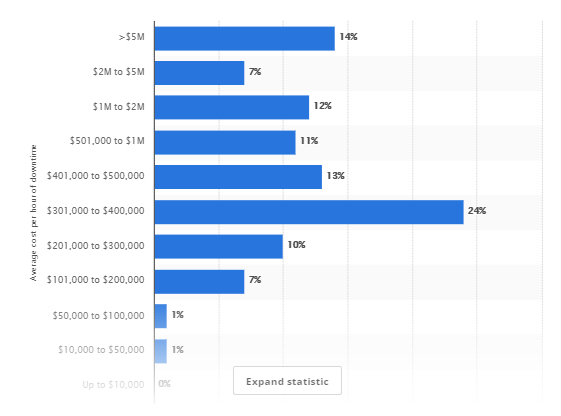Your IT setup is the backbone of your tax firm. When it’s secure, fast, and reliable, your team can focus on serving clients. When it’s outdated or unstable, every process suffers, from meeting filing deadlines to protecting sensitive data.
In a tax firm, technology isn’t just a tool. It’s the safeguard for client trust, the gatekeeper for compliance, and the engine that powers revenue. A single breach or extended outage during peak filing season can mean lost clients, potential fines under the FTC Safeguards Rule, and IRS 4557 violations.
As your firm grows, so does the complexity of your IT needs. What worked for a 3-person office may fail under the demands of a 20-person team, multiple office locations, or hundreds of concurrent client files. Recognizing the signs of outgrowing your current setup early lets you upgrade before downtime or a breach forces you to.
We’ve outlined 12 clear warning signs that your tax firm’s IT is no longer keeping up and what you can do to fix it before it costs you more than an upgrade would.
1. Frequent Downtime During Peak Filing Periods

Frequent downtime during busy filing season is the clearest sign your IT setup can’t handle your firm’s workload. Even short outages can throw off deadlines, disrupt e-filing, and leave staff scrambling to recover lost work.
For a tax firm, the cost of downtime isn’t just lost billable hours. It’s the cascading impact: missed client commitments, overtime pay for catch-up work, and potential compliance breaches if returns aren’t filed on time. Industry data shows that the average cost of IT downtime can exceed $5,000 per hour for professional services firms (Gartner). This suggests that even a few hours of outage in October can wipe out the profit from multiple client engagements. Which is a direct threat to both revenue and reputation.
Downtime spikes in tax season often mean your current infrastructure lacks the scalability, load balancing, or redundancy needed for high-demand periods. Shared cloud or on-premise setups without dedicated resources are especially vulnerable when traffic surges.
Upgrading to a dedicated private server environment like VeritSpace provides isolated resources, 99.995% uptime, and 24×7 monitoring. Eliminating competition for bandwidth with other tenants, ensures stable app performance for QuickBooks, Drake, Lacerte, and gives your team the reliability they need when every minute counts.
2. Staff Complaints About Slow or Unreliable Apps
If your team regularly complains about sluggish software, lagging logins, or tax applications crashing mid-task, your IT setup is holding them back. Slow systems don’t just frustrate staff, they multiply the time spent on each return, reduce productivity, and increase the risk of costly errors.
In most tax firms, the bottleneck isn’t the staff’s skills or speed, it’s the infrastructure running their tools. Accounting and tax applications like QuickBooks, Drake, and Lacerte require consistent processing power, high I/O speeds, and low-latency connections. When these needs aren’t met, tasks that should take minutes stretch into hours. This suggests that performance issues are often a server resource or network capacity problem, not a user problem. Interpret this as a red flag that your current environment isn’t optimized for the workload.
Common causes include:
- Shared hosting where multiple firms compete for the same resources
- Outdated hardware or operating systems
- Lack of SSD storage or proper memory allocation
- Weak remote access performance for hybrid or fully remote teams
3. Security Incidents or Rising Cyber Threat Alerts
If your firm has experienced phishing attempts, suspicious login activity, or even minor breaches in the past year, your IT environment is vulnerable. Cybercriminals target tax and accounting firms because they store sensitive client financial data and a single breach can trigger FTC Safeguards Rule violations, IRS 4557 noncompliance, and costly reputational damage.
According to the IRS, tax professionals are a prime target for identity theft schemes, especially during filing season. This suggests that even small firms are high-value targets. It’s important to see repeated threat alerts as a warning that your security controls and monitoring aren’t strong enough.
Common weak points include:
- No 24×7 security monitoring or threat response
- Shared servers with other firms, increasing attack surface
- Missing multi-factor authentication (MFA)
- Outdated antivirus or firewall configurations
- Lack of regular patching and vulnerability scans
4. Struggling to Meet FTC Safeguards Rule or IRS 4557 Requirements
If your firm scrambles to produce security documentation, doesn’t have a written information security plan (WISP), or can’t show proof of regular risk assessments, you’re at risk of noncompliance. The FTC Safeguards Rule and IRS Publication 4557 require tax professionals to protect client data through documented policies, encryption, and continuous monitoring.
Noncompliance can result in fines, loss of your e-file authorization, and reputational harm. This suggests that falling behind on compliance readiness is not just an IT issue, it’s a business continuity threat. See missed requirements as a sign that your current setup lacks the security architecture and process support to keep pace with regulations.
Typical compliance gaps include:
- No documented WISP reviewed annually
- Missing encryption for data in transit or at rest
- Incomplete access control policies
- No regular penetration testing or vulnerability scanning
- Failure to log and monitor all system access
5. Limited Remote Access or Poor Performance for Remote Teams
If your remote staff experience lag, frequent disconnections, or have to jump through multiple insecure workarounds just to access client files, your IT setup is limiting your team’s productivity.
Modern tax firms need secure, fast access from anywhere, whether during busy filing season or while supporting year-round advisory work.
When remote access is unreliable, staff waste time troubleshooting instead of serving clients. Worse, they may resort to unsafe shortcuts like emailing sensitive files to themselves or using unauthorized cloud tools.
This suggests that poor remote performance is not just a workflow problem, it’s a security and compliance risk. Take these issues as a sign that the environment isn’t built for hybrid or fully remote operations.
Common causes include:
- Public cloud hosting with no dedicated bandwidth for your firm
- Lack of optimized remote desktop protocols or VPN acceleration
- No MFA or session timeout controls for remote logins
- Insufficient server locations to minimize latency
6. Growing Client Data Volume Overloads Your Current Systems
If your servers are running out of storage, backups are taking longer, or searches in client files feel painfully slow, your IT environment is struggling to handle your firm’s data growth. Every new client, scanned document, and e-file adds to the load, and tax firms generate terabytes of sensitive data each year.
When storage is stretched thin, systems slow down, backups fail, and the risk of data corruption or loss rises. This suggests that inadequate storage isn’t just a capacity issue, it’s a threat to uptime, compliance, and client trust. This is a clear signal that their current infrastructure lacks scalability.
Warning signs of overloaded systems include:
- Frequent “low storage” alerts
- Backup jobs that fail or exceed their window
- Inability to run concurrent processes without lag
- Manual file archiving to free up space
7. No Disaster Recovery or Data Redundancy Plan You Trust
If your firm can’t quickly answer “How fast could we recover from a system failure or data loss?”, you have a disaster recovery gap. For tax firms, even a short disruption during filing season can cause missed deadlines, client penalties, and loss of e-file privileges.
A reliable disaster recovery plan ensures your data, applications, and workflows can be restored in hours, not days. Without it, you’re relying on luck, and luck is not a compliance strategy. This suggests that an untested or incomplete recovery plan is a direct threat to business continuity. Take the absence of proven redundancy as an unacceptable operational risk.
Common weaknesses include:
- Backups stored only on-site or on the same server
- No regular disaster recovery testing
- Long recovery time objectives (RTOs) and recovery point objectives (RPOs)
- Missing written protocols for disaster scenarios
8. Incompatible With Latest Accounting and Tax Software Updates
If your IT setup can’t support the latest versions of tax and accounting applications, you’re already falling behind. Vendors like QuickBooks, Drake, and Lacerte release updates to improve performance, add features, and patch security flaws.
When your environment can’t handle those updates, you’re left using outdated software and that’s a security and compliance liability.
Running older versions increases vulnerability to exploits and may make you incompatible with e-filing requirements or client data formats. Suggesting that update limitations are not just an inconvenience but they’re also a business and compliance risk.
Signs your IT is blocking updates:
- System requirements for new releases exceed your hardware specs
- Updates fail or cause performance issues
- IT postpones updates to avoid downtime
- You skip updates entirely to “keep things stable”
9. Rising IT Support Tickets and Maintenance Costs
If your IT support tickets are climbing month after month, your system isn’t just under strain, it’s consuming budget and productivity. Frequent issues with connectivity, application errors, or login failures force your team to stop working, wait for fixes, and often repeat the same process days later.
Every ticket costs more than the IT bill itself. You lose billable hours, client goodwill, and staff morale. This suggests that an increasing ticket volume is a lagging indicator of deeper infrastructure problems. This trend is a signal that patchwork fixes are no longer cost-effective, and a strategic upgrade will cost less over time.
Typical drivers of rising support costs:
- Outdated hardware requiring frequent repair
- Shared hosting environments causing resource conflicts
- Lack of proactive monitoring to catch issues early
- Reactive, not preventive, maintenance approach
10. Lack of Centralized Access Controls and MFA Enforcement
If you can’t easily see who has access to client data, adjust permissions, or enforce multi-factor authentication (MFA) across your systems, your firm’s security posture is exposed. Tax and accounting firms handle Social Security numbers, bank details, and sensitive income data, the kind of information that must be locked down with strict access controls.
Without centralized control, user permissions often become inconsistent. Departed employees may retain access, contractors might have broader rights than needed, and MFA adoption can be patchy. This suggests that weak access governance is not just an IT oversight, it’s a major compliance liability under the FTC Safeguards Rule and IRS 4557.
Risks from poor access control:
- Inability to revoke access quickly during staff turnover
- Unnecessary exposure of sensitive client data
- Higher likelihood of insider threats or credential theft
- Difficulty proving compliance during an audit
11. Client Concerns About Data Privacy and Security
If clients are asking how you store their information, whether it’s encrypted, or what protections you have against breaches, it’s a sign they’re thinking about risk and they expect you to have solid answers. In today’s climate, tax and accounting clients are more aware than ever of identity theft, ransomware, and data leaks.
When you can’t confidently explain your security measures, you risk losing business to firms that can. Visible client concern is not just a communication gap, it’s a competitive vulnerability. Take these questions as an opportunity to strengthen both your security and client messaging.
Triggers that raise client concern:
- Experiencing delays or errors in file delivery
- News of tax firm breaches in their area
- Hearing about IRS or FTC data protection rules
- Changes in their own industry compliance requirements
12. IT Can’t Support Your Strategic Growth Plans
If every new office location, staff hire, or service expansion triggers a major IT headache, your infrastructure isn’t built for growth. Scalable IT should let you onboard staff, deploy new applications, and handle more clients without months of planning or large and unpredictable expenses.
When IT becomes a bottleneck, it slows your ability to compete. This suggests that growth constraints aren’t just an operational nuisance but they can directly impact revenue potential and market share. Take any need to “pause growth until IT catches up” as a clear warning that your current setup has reached its ceiling.
Signs your IT is holding back growth:
- Rising IT spend with no measurable performance gains
- Delays in provisioning new user accounts or remote access
- Inability to quickly add storage or computing resources
- Systems that can’t integrate with new software or automation tools
How Verito Helps Firms Upgrade Without Downtime
Upgrading your IT shouldn’t mean weeks of disruption or risky migrations. At Verito, we’ve built a process that moves firms from outdated, high-risk setups to secure, high-performance environments, without interrupting daily operations.
Our migration specialists start with a full assessment of your current environment, identifying every application, integration, and compliance requirement. We then design a dedicated private server configuration in VeritSpace that mirrors your workflows, ensuring your staff can log in on day one with no learning curve.
Key elements of the Verito no-downtime upgrade:
- Pre-migration testing: Run all tax and accounting apps in a sandbox to confirm performance and compatibility.
- Phased cutover: Switch users in stages to avoid a single point of failure.
- 24×7 US-based support: Immediate help if any issue arises during or after migration.
- Compliance built in: SOC 2 Type II hosting, FTC Safeguards alignment, and IRS 4557 readiness from day one.
This approach ensures you not only solve your current IT pain points but also future-proof your operations with security, scalability, and tax-season reliability baked in.
Schedule a VeritSpace Demo to see how an upgrade can happen without downtime.
Conclusion – Secure, Compliant IT Is Non-Negotiable
Your IT setup is more than the wires, servers, and software behind the scenes — it’s the foundation of your client trust, compliance posture, and firm’s ability to grow.
If even a few of the signs in this list sound familiar, your current environment is already costing you in lost productivity, higher risk, and missed opportunities. Waiting until a breach, major outage, or compliance failure forces a change only increases the damage.
The firms that thrive during tax season and beyond are those that treat IT as a strategic investment, ensuring their infrastructure is secure, compliant, and ready to scale. With VeritSpace, VeritGuard, and VeritComplete, you get dedicated private servers, 24×7 US-based monitoring, and built-in FTC and IRS compliance support, all designed for the unique needs of tax and accounting professionals.














